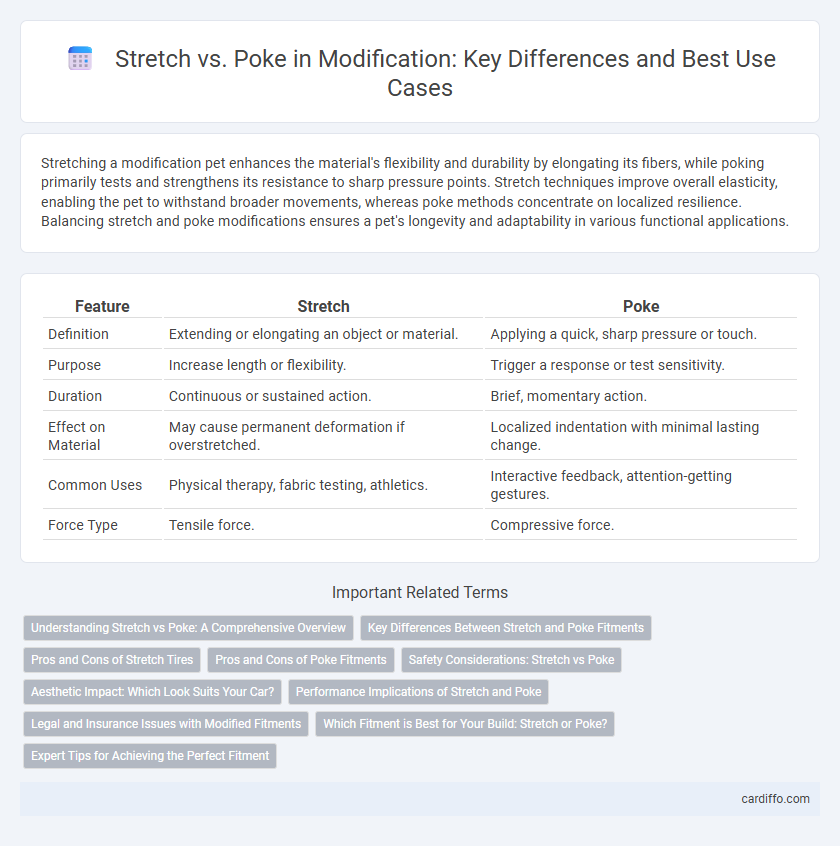Stretching a modification pet enhances the material's flexibility and durability by elongating its fibers, while poking primarily tests and strengthens its resistance to sharp pressure points. Stretch techniques improve overall elasticity, enabling the pet to withstand broader movements, whereas poke methods concentrate on localized resilience. Balancing stretch and poke modifications ensures a pet's longevity and adaptability in various functional applications.
Table of Comparison
| Feature | Stretch | Poke |
|---|---|---|
| Definition | Extending or elongating an object or material. | Applying a quick, sharp pressure or touch. |
| Purpose | Increase length or flexibility. | Trigger a response or test sensitivity. |
| Duration | Continuous or sustained action. | Brief, momentary action. |
| Effect on Material | May cause permanent deformation if overstretched. | Localized indentation with minimal lasting change. |
| Common Uses | Physical therapy, fabric testing, athletics. | Interactive feedback, attention-getting gestures. |
| Force Type | Tensile force. | Compressive force. |
Understanding Stretch vs Poke: A Comprehensive Overview
Stretch involves extending a material or surface beyond its original length, enhancing flexibility and adaptability. Poke refers to localized pressure or indentation applied to a material, often affecting its texture and structural integrity. Understanding these differences is crucial in manufacturing and product design for optimizing material performance and durability.
Key Differences Between Stretch and Poke Fitments
Stretch fitments rely on elastic materials to expand and conform, providing a snug, flexible hold ideal for varied sizes and shapes. Poke fitments use rigid or semi-rigid components that insert into a designated slot or hole, offering a secure, fixed connection that resists movement. Key differences include flexibility, with stretch fitments accommodating dynamic changes, while poke fitments ensure stability and precise positioning.
Pros and Cons of Stretch Tires
Stretch tires enhance wheel fitment by allowing wider rims to be mounted without rubbing, improving cornering stability and aesthetic appeal. However, they compromise tire sidewall flexibility, leading to increased risk of sidewall damage, reduced ride comfort, and potential safety concerns under high stress. The trade-off between aggressive styling and functional performance should be carefully considered for optimal vehicle modification.
Pros and Cons of Poke Fitments
Poke fitments offer precise alignment and secure fastening, making them ideal for applications requiring consistent positioning and durability. However, their installation can be more time-consuming compared to stretch fitments, and they may require specialized tools or equipment. The rigidity of poke fitments limits flexibility, potentially increasing the risk of damage under dynamic or thermal expansion conditions.
Safety Considerations: Stretch vs Poke
When evaluating safety considerations in Modification, stretch techniques pose less risk of tissue damage compared to poke methods, which can penetrate and harm underlying structures. Stretch modification distributes force evenly over a larger area, minimizing injury, while poke modification concentrates pressure, increasing the likelihood of punctures and infections. Proper training and sterile equipment are essential to mitigate risks associated with poke modifications.
Aesthetic Impact: Which Look Suits Your Car?
Stretch tires create a sleek, aggressive stance by tucking wider tires under narrow rims, enhancing the car's visual width and sporty appeal. Poke tires extend beyond the fender line, providing a bold, muscular look that emphasizes wheel size and offset. Choosing between stretch and poke depends on your car's style goals, with stretch favoring a clean, lowered appearance and poke delivering a more rugged, attention-grabbing aesthetic.
Performance Implications of Stretch and Poke
Stretch operations can improve performance by enabling dynamic resizing of elements without the need for recalculating layout positions, reducing rendering overhead in responsive designs. Poke modifications, involving direct updates to specific data points or components, allow for targeted optimizations that minimize processing time and avoid unnecessary reflows. Both techniques impact performance differently: stretch excels in fluid adaptability, while poke optimizes precision and resource allocation during incremental changes.
Legal and Insurance Issues with Modified Fitments
Legal regulations regarding modified vehicle fitments, such as stretched or poke tires, vary by jurisdiction and often impact roadworthiness certification and insurance coverage. Stretched tires can be deemed unsafe due to increased risk of tire bead failure, potentially leading insurers to deny claims or increase premiums in the event of accidents. Poke fitments that extend beyond fender lines frequently violate local vehicle laws, risking fines, failed inspections, and nullified insurance policies.
Which Fitment is Best for Your Build: Stretch or Poke?
Stretch fitment enhances tire flexibility by mounting wider tires on narrower rims, improving grip and aesthetics but potentially sacrificing sidewall support. Poke fitment involves using wider wheels that extend beyond the fender, offering aggressive stance and improved cornering clearance while risking fender damage and reduced aerodynamics. Choosing the best fitment depends on your build's goals: prioritize stretch for performance and comfort or poke for visual impact and track capability.
Expert Tips for Achieving the Perfect Fitment
Expert tips for achieving the perfect fitment emphasize precise measurement and material selection to balance stretch and poke effectively. Stretch involves slight tire width reduction for a sleek appearance, while poke allows the tire to extend beyond the wheel arch, making vehicle stance more aggressive. Proper alignment and suspension adjustments are crucial to ensure safe handling and avoid excessive wear during modifications.
stretch vs poke Infographic

 cardiffo.com
cardiffo.com